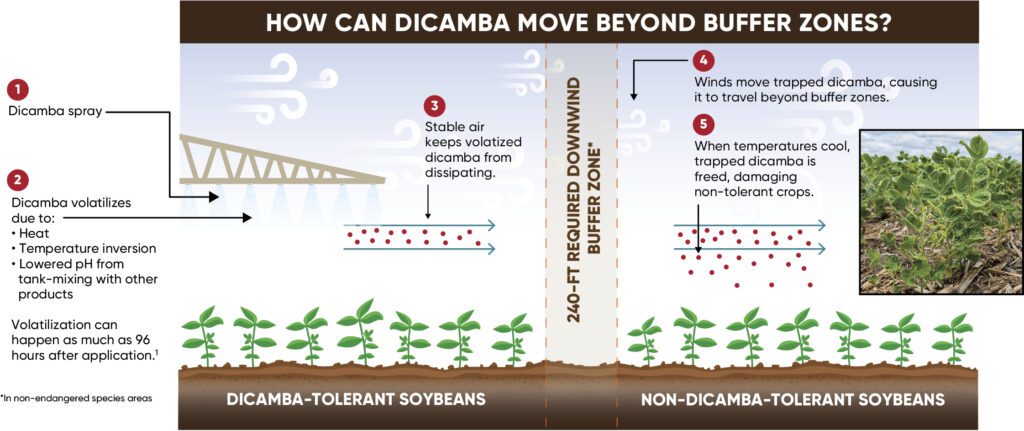You’ve no doubt heard a lot of talk about instances of widespread injury to non-dicamba-tolerant soybeans. Many farmers have reported fields with distinct dicamba symptomology, uniformly visible across fields. Weed scientists and university extensions have been investigating this issue and looking for possible explanations for what is causing in-crop dicamba to apparently move beyond labeled buffer zones. These experts believe that, under certain conditions, volatilized dicamba is likely becoming “trapped” in the air, where it can then move to distant fields.
What’s the difference between volatility and drift?
Drift involves immediate movement of fine spray droplets with the wind, before a herbicide has landed on its intended target. Physical drift creates a distinguishable pattern of symptomology downwind from the application site. But widespread, uniform, distant injury more likely happens as a result of volatilization: After the herbicide has landed on its intended target, a chemical reaction causes the herbicide to turn from a liquid to a vapor, which then goes into the atmosphere where it can become trapped in still air. When air movement returns, the trapped vapor travels to a distant field, possibly well past buffer zones required for in-crop dicamba products.
How much does it take to cause injury?
Visible injury to non-dicamba-tolerant soybeans can occur at amounts as low as 1/20,000th of the labeled use rate of dicamba.2 At the 2019 Weed Science Society of America proceedings, a University of Arkansas weed scientist reported seeing 10% soybean injury with dicamba air concentrations of just 1 nanogram per cubic meter,1 or 1 part per trillion.
1 Unglesbee, Emily. “Dicamba Data Download: Scientists Illuminate the Causes of Volatility and Off-Target Dicamba Injury at WSSA.” Progressive Farmer. February 15, 2019. https://www.dtnpf.com/agriculture/web/ag/crops/article/2019/02/15/scientists-illuminate-causes-target-2.
2 Bish, Mandy D., Shea T. Farrell, Robert N. Lerch, and Kevin W. Bradley. “Dicamba Losses to Air after Applications to Soybean under Stable and Nonstable Atmospheric Conditions.” Journal of Environmental Quality 48 (2019): 1675-1682.
™ ® Trademarks of Corteva Agriscience and its affiliated companies. © 2023 Corteva.
